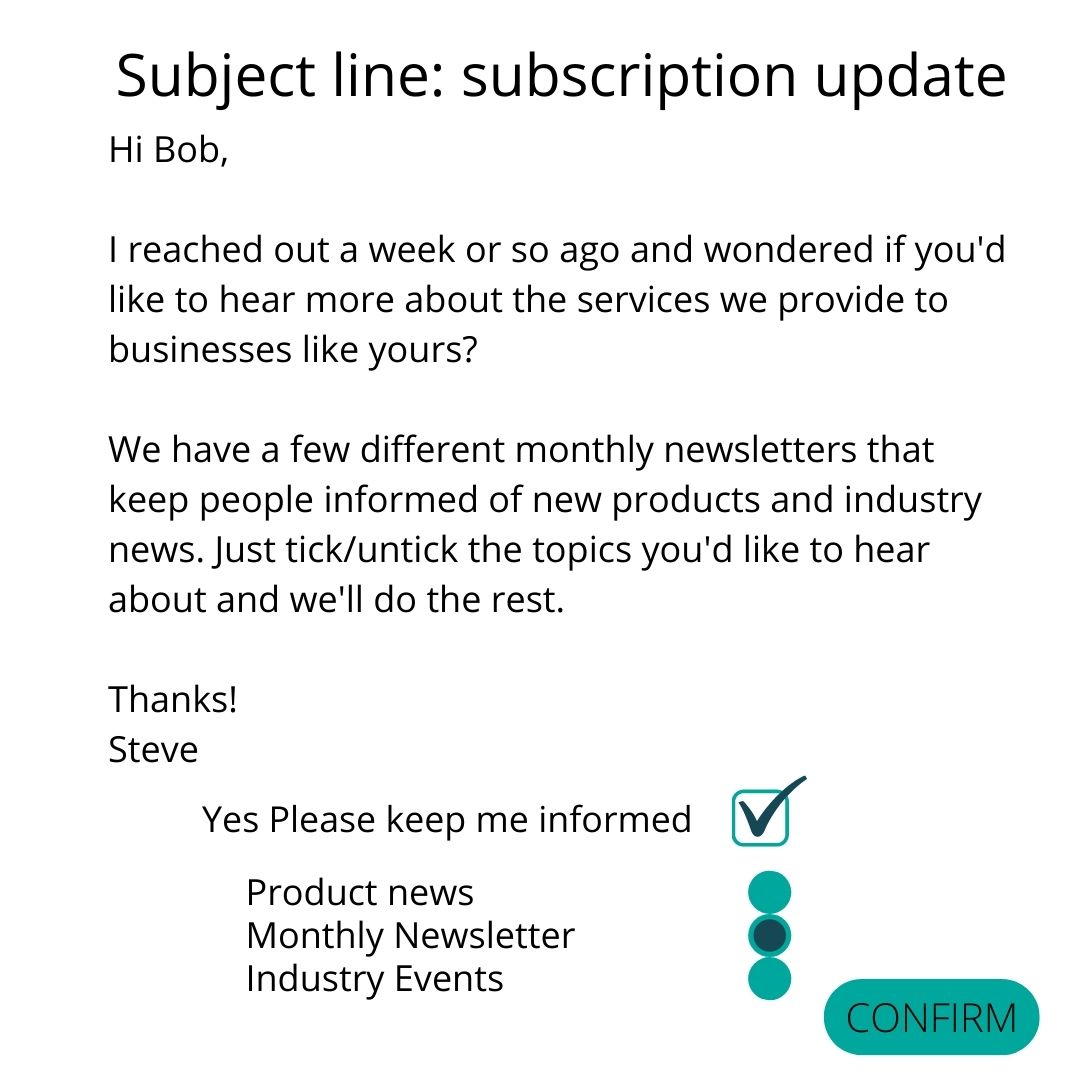There are two broad approaches you can take with email marketing – inbound or outbound. Which you choose will depend on the type of business you have, where your customers are and how much time you’re willing to invest. You may even choose to combine inbound and outbound strategies to ensure a continuous stream of customers for your products or services.
There’s a lot of ground to cover with email marketing. Here we look at outbound strategies. In a future blog, I’ll cover inbound strategies and then another for writing the ‘perfect’ email. Before we get into the how of outbound email, let’s take a look at the different regulations for digital marketing.
A nod to email regulations
There are various acts that outline what is and isn’t acceptable practice for outbound cold emailing. The last thing you want to do is end up on a spam blacklist, or worse, being served a fine for reaching out to potential customers.
If your customers are in the United States, make yourself aware of the ins and outs of the CAN-SPAM Act. For Canadian prospects, you’ll need to become familiar with the Canadian Anti-Spam Legislation (CASL) and for the UK and Europe it’s GDPR compliance you need to check through. Japan also has specific guidelines for email communications.
Contravening these rules can result in anything from turning prospects off your business for life to hefty fines that are high enough to cripple a small enterprise. Other parts of the world aren’t currently covered by specific legislation for electronic communications, but it’s worth sticking to some general email guidance to avoid being marked as a ‘spammer’.
It’s good practice to always show some courtesy and respect people’s information. So, as a rule of thumb…
- Be clear about who you are and where you are from (business and physical location)
- Be transparent and honest with your subject line – no misleading, clickbaity hooks
- Ensure you have a legitimate reason for the email – i.e.: you genuinely think the recipient would be interested in your offer. This may be because they’ve signed up for your emails, or because you know they fit your customer profile
- Put you reason for emailing up front, don’t waste recipients time or be opaque about the reason for your message
- Make your opt-out option easy to find and choose. If it is chosen honour the choice quickly and fully
Each of the email-specific acts noted above have their own additional idiosyncrasies. For example, GDPR requires B2C email senders to have explicit, affirmative and specific permission from the receiver before sending a personal email. That means sending emails asking customers for permission to send marketing messages is also out. GDPR guidance for B2B is a little different – targeting prospects that are relevant and legitimate receivers for your offer is fine, as long as you remain within the other rules.
Given all these laws that are backed up with some fairly spikey reprimands for over-stepping, you may be thinking that outbound email marketing campaigns are in their death throes. Fortunately, that’s not the case. Both inbound and outbound email marketing is still effective and provide some of the strongest ROI for all marketing methods. What’s more, conversion rates are higher than social media, direct traffic and search according to Smart Insights.
Because I’m based in the UK, this piece leans toward GDPR. My understanding is that it’s one of the strictest levels of regulation in place to date. Even if you’re in the US, you’ll need to be aware of these rules if your customers are in the UK or Europe. But GDPR isn’t just about email, it’s about data and how it’s collected and stored.
Outbound Email Strategies for B2B
B2B email strategies are pretty straightforward. As with most things, the most successful outbound email strategies begin with research. For B2B lead generation, take some time finding businesses to target. It saves time in the long run, increases your conversion rates and keeps you on the right side of the law.
A great place to start with researching details for leads is Google and LinkedIn. Consider who your complementary businesses are. For example, as a freelance copywriter, likely business candidates for my service include website developers and marketing agencies. When finding your ideal business customer take some time to dig a little past the generic info@ email address. You want to get to the right decision maker – this is not necessarily the business owner or CEO. In some cases it could be the head of a particular department or a senior member of staff.
As soon as you begin compiling an email list, you’re treading on sensitive ground for data protection. I cannot stress enough that you’ll need to make sure there is a relevant and legitimate reason to collect these prospect’s details. Make sure the list you are pulling together is secure too.
Key information to find is the business name, contact person’s name, job title, email address (obviously), contact number and location is also key. Entering this information into a spreadsheet as you go makes it simpler further down the track to load into an email service platform. I use MailChimp, but it isn’t the only option. There are plenty of email marketing campaign platforms. Most come with a free trial as bare minimum, some with free and paid subscription levels of service. But more about this later.
Before you adding anything to your campaign contacts lists, I suggest reaching out personally. You’ll need to send this first contact within 30 days of collecting the information to be GDPR compliant. A simple DM on LinkedIn is a great way to introducing who you are and ask if you can reach them by email. If they agree, send them an adapted version of the message below.
Alternatively, send an email introduction to the address you sourced. If you hear back from the recipient with a request to be removed from your email outreach, comply with their wishes ASAP. If you don’t hear back, you can follow up with a quick email seeking opt in for your email list.
Something like this is all you need:

Once you hear back, go ahead and add them to the appropriate campaign lists. If you don’t hear back after 30 days, remove them from your list. If you get a response asking why your emailing, respond politely and honestly, then either remove or add them to your campaign list depending how the exchange plays out.
When you have obtained the introduction and explicit permission, you’re free to go ahead with your email sales campaigning, gently qualifying and coaxing contacts through the sales and marketing funnel to become happy and loyal customers.
Compliant B2C Outbound Email Strategies
Outbound B2C from a GDPR perspective is largely untenable if you’re starting out with cold emails. It’s also a bit of a minefield from a CAN-SPAM and CASL perspective too. There are a few tactics that work while remaining compliant.
Most people have an affiliation with a business. For example, if you’re a painter and decorator, your key customer base is likely people with homes and apartments. It’s conceivable that you could gain access to large numbers of customers by emailing the business these people are linked to. For example, you could check out the apartment blocks in your area. Find the details of the management and send them an email about who you are and what you do with a request for them to share that with their community.
When reaching out, strike the balance between friendly and professional. Give all the relevant information up front so the recipient knows why you’re getting in touch.
Because CAN-SPAM and CASL doesn’t require explicit permission to email, if your customers are in the US or Canada, feel free to reach out. Again, the relevancy and legitimacy rule applies. Don’t go emailing everyone in an area about your painting business – college student Jimmy probably isn’t a great prospect and the relevancy and legitimacy is tenuous at best.
When you send that first email, make sure you take each of these steps
1. Make sure it’s relevant. I know I said it numerous times, but it’s key to compliance across so many regulations it’s worth saying it again.
2. Be clear, get personal. Use names and be upfront about why your getting in touch in the subject line. Something like ‘Cut price painting this April, just for you Samantha’ cuts to the chase while being interesting enough to open.
3. Return to sender. Elvis’ song lyrics are not your guidance here, if the address is unknown you’ll get marked as a spammer and be dancing on the thin line of non-compliance for CAN-SPAM and CASL. Make sure people know who the email is from. Don’t go lookin’ for trouble.

4. Easy opt-out. Don’t make people hunt for the unsubscribe, make it quick, easy and painless. Remember that sending emails or any type of marketing to people that aren’t interested is a waste of your money and both of your time.
5. Where are you? Include your business address. Again, this is about compliance and transparency. It also gives credibility to your email and your service.
Email marketing is alive and well. It’s one of the cheapest ways to reach your audience. Outbound isn’t dead, but it does take some thinking to stay on the right side of the law. Do your research and only contact relevant business or customers for your service of product. Make sure you keep the data you collect safe and contact the people you’ve found in a timely manner. If someone wants to opt out, get them off your list post haste. Gain permission and confidently set sail for marketing your business. Happy emailing!



Recent Comments